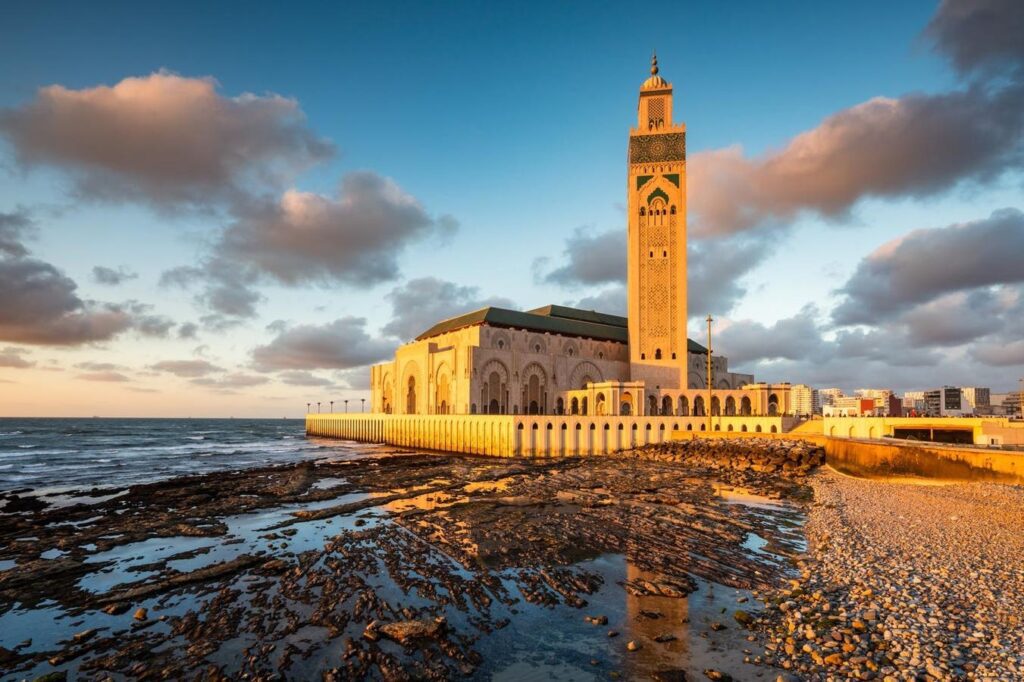Hassan II mosque at sunset, Casablanca, Morocco
getty
In just over five years, there’s a good chance that you will be able to board a high-speed train in Madrid and travel from Spain to the Moroccan city of Casablanca in five and a half hours, hurtling through a new tunnel under the Strait of Gibraltar. This may sound like something from a Jules Verne novel, but it was first discussed by Spain and Morocco in 1979. They even did feasibility studies through 1981, but the project failed to progress beyond that point.
Spain and Morocco are now reconsidering this ambitious undertaking, spurred in large part by the approaching 2030 FIFA World Cup. It will mark the centennial World Cup competition, and for the first time, three countries from two continents will host the competition: Spain, Morocco, and Portugal. Fans will want to travel between these countries for matches as quickly and efficiently as possible. They might as well do so on a 21st century engineering marvel.
The Moroccan National Company for Strait Studies (SNED) has announced that it has begun researching the project’s viability, called the Euro Africa Gibraltar Straight Fixed Link. Spain commenced such studies in 2023 under the aegis of the Spanish Society for Fixed Communication Studies across the Strait of Gibraltar (SECEGSA).
Two high speed trains “Al Boraq” operated by the ONCF at Tanger-Ville Railway Station
getty
Some of the impetus for rethinking this project came after Morocco completed its first high-speed rail project, a train that connects Casablanca with Tangier, in 2023. It’s now not only the fastest train on the African continent, but it demonstrated that the country was ready for another significant rail challenge.
Gibraltar Rock and La Linea de la Conception, with Morocco in the background.
getty
The Strait of Gibraltar, at its narrowest point, is just a nine-mile gap between the European and African continents. Now, imagine the convenience of a high-speed underwater rail tunnel connecting Spain and Morocco. It’s projected that this tunnel could reduce travel time from Madrid to Casablanca to just five and a half hours, a significant improvement from the current 12-hour journey by car and ferry or the two-hour flight, the latter much longer when you factor in travel time to and from airports.
Departing Madrid, there would be a stop in the Spanish city of Algeciras, at the southern end of the Iberian Peninsula, near the Strait of Gibraltar. The train would then head into a tunnel under the Strait of Gibraltar, running between Punta Paloma in Spain and Punta Malabata in Morocco. Its next stop would be the city of Tangier in Morocco before reaching its final destination, Casablanca. Between Algeciras and Tangier, the distance would be about 26 miles, with 17 miles of track in the undersea tunnel. At its lowest point, the tunnel would lie about 985 feet below sea level, with a maximum gradient of about 3%.
Madrid, Spain cityscape at Calle de Alcala and Gran Via.
getty
This would be the first-ever rail link between the two continents, and the primacy of the World Cup aside, it would connect and open up existing rail routes in both countries and far beyond. SECEGSA suggests it could carry up to 12.8 million passengers between continents annually. The construction costs are unknown, but estimates are between $7 and $8 billion.
There is currently no deadline or project start date. Financing will presumably come from the host countries, Spain and Morocco, with additional support from sources such as the European Union. Yet, at a time when high-speed rail has become more popular than ever across Europe, it’s an inventive, imaginative, and exciting project that appears to have a decent chance of succeeding.
Source link : https://www.forbes.com/sites/everettpotter/2024/06/23/an-underwater-rail-tunnel-may-link-europe-with-africa-by-2030/
Author :
Publish date : 2024-06-23 01:15:00
Copyright for syndicated content belongs to the linked Source.
